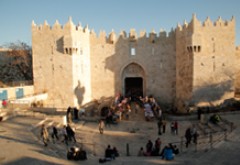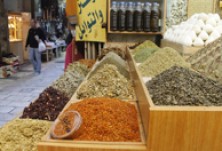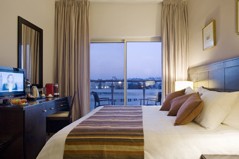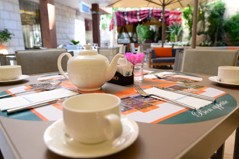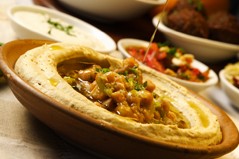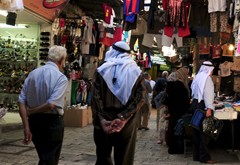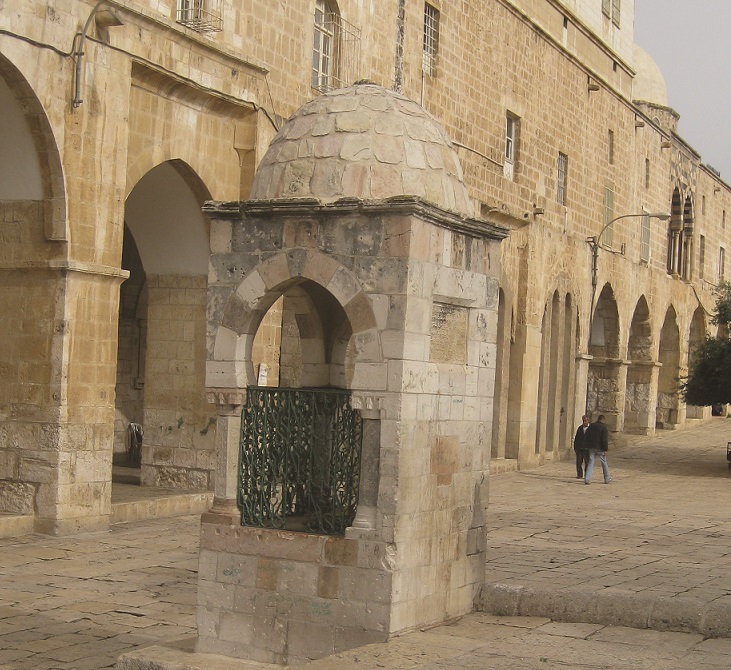A short walk of about 20 meters southwest of Bab al-Nazir leads to this Sabil, located in the northwestern part of al-Aqsa Mosque courtyard.
Sabil’s Names and Location
Sabil Mustafa Agha is actually the smallest and most beautiful of al-Aqsa Mosque’s Sabils. It was known as Sabil al-Shaikh Budair and Sabil ’Uthman al-Fiqari. It was built at the northwestern corner of a stone mastaba (bench), the south of which is a mihrab (a prayer niche). The Sabil is independently structured with the exception of its eastern side, which is adjacent to the mastaba mentioned above.
Water Source
Water used to be brought for the Sabil from nearby sources by special water men, appointed by the founder of the Waqf, and unloaded into the only stone trough under the Sabil’s dome. Its water was described as ‘fresh and quenching thirst.’
Sabil’s Aesthetics
Despite its small size of 1.5 square meters, the Sabil enjoys a unique, balanced design and profound artistic taste. It is a piece of art waiting for someone to give it a deep and appreciative look, and to understand it in order to appreciate it. The beauty of this Sabil is not restricted to its architectural plan but includes its detailed expressive ornaments, representing the ideas of the basic pattern.
The inscription on the Sabil’s eastern façade reads as follows:
The sabil was built by him who has the utmost sovereignty, who has excelled by means of his donations,the most generous Mustfa, Governor of Jerusalem. Its water is similar to that of Paradise, it is sweet, it is a cure, it deserve to be drunk. His Highness ‘Uthman Beg al-Fiqari ordered the building of this sabil,opting for reward on the Day of Judgment, and hoping to be considered among those who are blessed. Both Mustafa and ‘Uthman hope to drink from the basin of Taha(i.e. the prophet Muhammad). How lucky they are to fulfilsuch a wish!both rae lucky; for both shall drink from a cup of nectar. In the year 1153.
Founder
The Sabil was built by Mustafa, governor of Jerusalem in 1740 - 41 AD (1153 H). His full name is Mustafa Agha Parwana Zade; he ruled Jerusalem for 20 years (1731 - 1751 AD / 1144 - 1165 H). He took a pledge from the residents of al-Bira, Bait Hanina, and Bait Iksa not to attack travelers to the city of Jerusalem.
Description of the Sabil
The Sabil is built on a square base carrying four ornamented small columns, resting in turn on three arches opening to the north, west and south. The fourth, eastern side is a solid wall. The horseshoe arches support a small dome that has recently been covered with stone tiles.
Hence, the Sabil is composed of three parts: a square base, a four-facades , and a small dome. The upper part of the base contained a stone basin, 0.85 meters long and 0.40 meters deep, which used to contain water, probably brought by water suppliers from al-Aqsa Mosque wells. In 1988, however, the basin was filled and paved to prevent the accumulation of waste.
Sabil’s Ornaments
The four columns have common characteristics, including size, shape, round bases, and stalactite (muqarnas) capitals. The theme and elements of the decoration around the column bodies are evidently different in theme and number of ornamented sides. While the northeastern and northwestern columns carry rigid architectural motifs with recurring triangles, the columns in the southwestern and southeastern sides carry expressive plant motifs in two forms. The first is a cup, serving as a vase, from which a branch shoots along the full length of the column, from which leaves and small, multi-petal flowers and fruits in the shape of pears and pomegranates branch off. This type of ornament is present in three sides of the column in the southwestern corner. The second ornamental form is a band of plant ornaments, covered with various types of small plants.
Ornaments’ Message
The Arabesque ornaments project a symbolic message in addition to their artistic one, signaling heaven and the reward awaiting those who are charitable. It seems that the talent of the poet teamed with the artist’s hand to depict the thoughts of the founder in terms of material images of drinking pure and refreshing water from his Sabil, in tin cups, compared, on the spiritual side, with hope to drink from the Prophet’s trough in heaven. The ornaments express this very well. It is noteworthy that some of these ornaments are connected to the description of heaven in the Holy Quran. Reference to heaven and its beauty are clear in the inscription. Note that the columns which include the ornaments face Mecca (al-Qibla).

